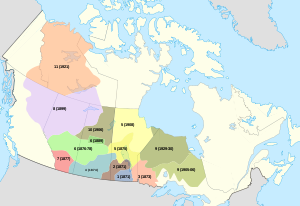This article has multiple issues. Please help improve it or discuss these issues on the talk page. (Learn how and when to remove these messages)
|
| Treaty and Supplementary Treaty No. 7 between Her Majesty the Queen and the Blackfeet and Other Indian Tribes, at the Blackfoot Crossing of Bow River and Fort Macleod | |
|---|---|
 The Numbered Treaties | |
| Signed | September 22 and December 4, 1877 |
| Location | Blackfoot Crossing, Fort Macleod |
| Parties | |
| Language | English |
| Indigenous peoples in Canada |
|---|
 |
|
|
Treaty 7 is an agreement between the Crown and several, mainly Blackfoot, First Nation band governments in what is today the southern portion of Alberta. The idea of developing treaties for Blackfoot lands was brought to Blackfoot chief Crowfoot by John McDougall in 1875.[1] It was concluded on September 22 and December 4, 1877.[2] The agreement was signed at the Blackfoot Crossing of the Bow River, at the present-day Siksika Nation reserve, approximately 75 km (47 mi) east of Calgary. Chief Crowfoot was one of the signatories to Treaty 7. Another signing on this treaty occurred on December 4, 1877, to accommodate some Blackfoot leaders who were not present at the primary September 1877 signing.
Treaty 7 is one of eleven Numbered Treaties signed between First Nations and the Crown between 1871 and 1921. The treaty established a delimited area of land for the tribes (a reserve), promised annual payments, provisions, or both, from the Crown to the tribes and promised continued hunting and trapping rights on the "tract surrendered". In exchange, the tribes ceded their rights to their traditional territory, of which they had earlier been recognized as the owners.
Britain had transferred whatever jurisdiction over "Indians and lands reserved for the Indians" it may have had to the Province of Canada in the 1840s. This authority devolved to the government of Canada at Confederation in 1867 and applied to the area of the North-Western Territory and Rupert's Land that were transferred to Canada in 1870, including the part that became Alberta in 1905. The British government, in an exchange of letters at the time of the transfer, sought assurances that Canada would provide the Crown's obligation to First Nations.

- ^ Tesar, Alex (August 9, 2016). "Treaty 7". The Canadian Encyclopedia. Retrieved February 5, 2018.
- ^ "Copy of Treaty & Supplementary Treaty No. 7 Between Her Majesty The Queen and The Blackfeet and Other Indian Tribes" (PDF).